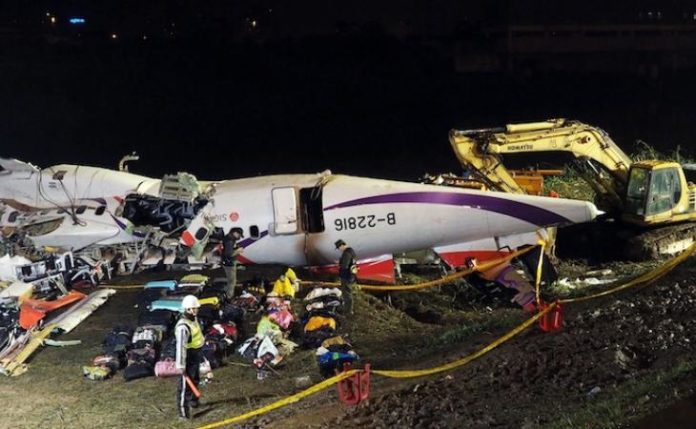Troubled Taiwan carrier TransAsia Airways Corp. has been barred from applying for new flight routes for the year ending February 4, 2016 following its deadly crash in Taipei on Wednesday that claimed at least 31 lives, the Taiwanese civil aviation authority announced yesterday. Taiwan officials said yesterday that they were still interpreting the data from the recovered black box of the crashed plane, saying that they could announce the content today. But the investigation of the deadly incident could take a year, Taiwan’s Civil Aeronautics Administration (CAA) said yesterday. The CAA has also decided to ban new air rights applications by TransAsia Airways – for instance, to apply for a new flight route – for a year ending February 4, 2016. However, the wholly-owned budget carrier business of TransAsia, branded as V Air, would not be subject to the ban as the budget carrier operated independently from its mother company, CAA said yesterday. In a statement released on Wednesday night, Macau’s Civil Aviation Authority noted that the engines of the turboprop ATR72-600 aircraft that crashed had been replaced at Macau Airport on April 19 last year, during its delivery flight when the plane encountered ‘engine-related technical issues’. The Authority further added that the engines were replaced by TransAsia engineers and that the plane left Macau Airport two days later. “We decided to land at Macau Airport because at that time we detected that there were some problems with the engines which needed a replacement. It was during its delivery flight from Toulouse in France en route to Taiwan,” a spokesperson from TransAsia Airways explained to Business Daily. The head of CAA, Lin Tyh-ming, said the aircraft last underwent maintenance on January 26. The plane was powered by two Pratt & Whitney PW127M engines. Pratt & Whitney is part of United Technologies. The last communication from one of the pilots was “Mayday, Mayday: engine flameout”, according to an air traffic control recording on liveatc.net. A flameout occurs when the fuel supply to the engine is interrupted or when there is faulty combustion, resulting in an engine failure. Twin-engined aircraft, however, are usually able to keep flying even when one engine fails. “At this moment we really cannot comment on whether the engines issue is the cause of the incident, as we still have to wait for the result of the investigation on it,” a spokesperson from TransAsia Airways remarked to us yesterday. China aid TransAsia Flight GE235, carrying 58 passengers and crew, lurched between buildings, clipped an overpass with one of its wings and crashed upside down into shallow water shortly after taking off from a downtown Taipei Airport on Wednesday. The plane was bound for the Taiwan island of Kinmen. At least 31 people were killed when the plane crashed. There were 15 known survivors and 12 more unaccounted for. The pilot and co-pilot of the almost-new turboprop ATR 72-600 were among those killed, CAA said. Meanwhile, 18 of those killed were from among a group of 31 Chinese tourists, most from the southeastern city of Xiamen, it said. Three Chinese passengers were rescued. China President Xi Jinping expressed condolences to the relatives of the deceased on Wednesday, urging an immediate rescue of the injured. China would assist in the investigation into the incident, a spokesman from Taiwan’s Executive Yuan, Mr. Sun Li Qun, said yesterday. This was also the first time that mainland China has extended help to Taiwan over plane accidents. The crash was the latest in a string of aviation disasters in Asia over the past 12 months. Taiwan has had a poor aviation safety record in recent years, including the disintegration of a China Airlines 747 on a flight from Taipei to Hong Kong in 2002, killing 225. One of TransAsia’s ATR 72-500 planes crashed while trying to land on Penghu Island last July, killing 48 people. The disappearance of a Malaysia Airlines jet last March and the downing of a sister plane over Ukraine four months later resulted in the combined loss of 537 lives. The crash of an AirAsia jet bound for Singapore from Indonesia on December 28 killed all 162 people on board. with Reuters Valuable routes insulate TransAsia from grim crash record Even after two deadly crashes in seven months, TransAsia Airways Corp. will likely rebound quickly as insurance covers any financial losses and its coveted routes through Taipei’s downtown airport make it popular with business travellers, Reuters reported. Airline analysts said that the carrier may have to offer discounts to lure back passengers after Flight GE235 ended in at least 31 fatalities on Wednesday. Amateur video from a car dashboard camera showed the plane clipped a taxi and a bridge before smashing upside down in a shallow river. “Songshan [airport] is in downtown Taipei… so their flights are valuable, especially for the corporate guys,” said Marc Wang, manager at KGI Securities in Taiwan. “I don’t think they’ll give up the business.” TransAsia operates about 22 daily flights from Songshan, mainly to domestic destinations but also to a few Chinese cities, including Shanghai. Taiwan Fire & Marine Insurance Co. Ltd. said it had underwritten TransAsia’s aviation hull and passenger liability insurance and estimated its maximum retained loss at US$225,000, which it said would have no significant impact on its business. Two other insurers, Cathay Financial Holding Co. Ltd. and Mega Financial Holding Co. Ltd., said they expected no significant financial impact from related claims. Wednesday’s crash and another fatal accident in July mean TransAsia is suspended from opening new routes, which will set back its ambition to grow as a regional carrier, said Michael Lee, Taiwan airlines analyst at Primasia Securities in Taipei. “It’s a problem for TransAsia because for the last two or three years TransAsia has been working pretty hard to shift its focus from the domestic market to the regional market,” Lee said. “The margin of the domestic routes is much lower than the regional routes.” TransAsia bounced back quickly from the July crash. Revenue passenger kilometres – a measure of an airline’s traffic – dropped 64 per cent in July from June but rebounded in August, JihSun Securities Investment wrote in a research note. Insurance covered all compensation claims, it said.
—
























